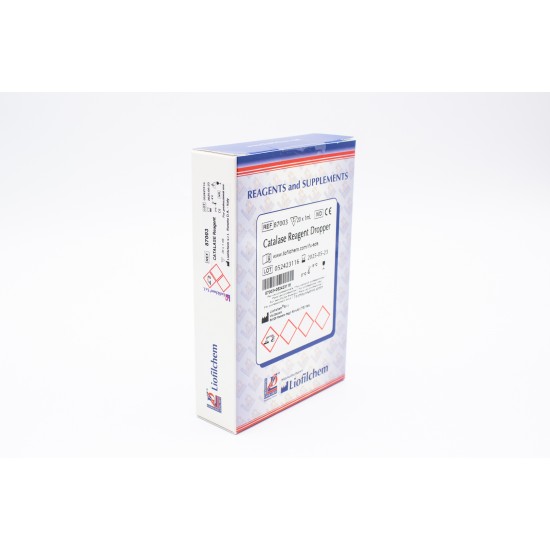Liofilchem CATALASE Reagent Droppers, 1 mL
Catalog No :
CAS Number :
Brand :
In Stock
Specifications:
| Application | Microbiology | ||
| Storage Temperature | 2-8°C | ||
| Product Type | Biochemical Reagent | Forms | Liquid |
| Product Brand | Liofilchem | ||
| Product Grade | Microbiology grade | ||
The Liofilchem™ Catalase Reagent Droppers are a diagnostic solution designed for the rapid detection of the catalase enzyme in bacterial isolates. This test is a critical aid in differentiating catalase-positive and catalase-negative microorganisms, such as Staphylococcus spp. and Streptococcus spp., respectively. The reagent is provided in a convenient dropper format containing hydrogen peroxide (~3%), ensuring ease of use and precision in catalase testing workflows.
Key Features
- Ready-to-Use Dropper Bottles:
- Pre-prepared hydrogen peroxide reagent for immediate use.
- Accurate Catalase Detection:
- Produces visible gas bubbles in the presence of catalase-positive bacteria.
- Convenient Packaging:
- Includes 20 dropper bottles, each containing 1 mL, ideal for small- to medium-scale laboratories.
- Standards Compliant:
- Validated for performance with a range of control strains, meeting laboratory quality standards.
- Multiple Test Formats:
- Suitable for slide, tube, agar plate, and broth catalase testing methods.
Kit Contents
- 20 dropper bottles (1 mL each) containing ~3% hydrogen peroxide.
Intended Use
- Detect the catalase enzyme in bacterial isolates for microbial differentiation and identification.
- Primarily used in clinical microbiology for diagnosing infections caused by catalase-positive bacteria.
Method Principles
- Catalase-positive microorganisms break down hydrogen peroxide into water and oxygen, resulting in visible gas bubbles.
- Catalase-negative microorganisms do not produce bubbles.
Test Procedures
Slide Test Method
- Obtain a pure culture of the organism to be tested.
- Transfer a well-isolated colony onto a glass slide using an inoculating needle or applicator stick.
- Add 1–2 drops of the catalase reagent directly onto the smear.
- Examine immediately for rapid gas bubble production.
Tube or Agar Plate Method
- Add a few drops of the catalase reagent to the surface of an 18–24 hour agar plate or slant (ensure no blood-containing media is used).
- Observe immediately and after 5 minutes for bubble formation.
Broth Method
- Add the catalase reagent directly to a 24–48 hour broth culture.
- Examine immediately and after 5 minutes for gas bubbles.
Interpreting Results
- Positive Reaction: Visible bubble formation indicates catalase enzyme activity.
- Negative Reaction: No bubble formation.
Performance Characteristics
- Validated using the following control strains:
- Staphylococcus aureus (Positive reaction: gas bubbles).
- Listeria monocytogenes (Positive reaction: gas bubbles).
- Enterococcus faecalis (Negative reaction: no bubbles).
Storage and Shelf Life
- Store at 2°C to 8°C in its original packaging.
- Shelf life: 2 years from the date of manufacture.
Applications
- Clinical Microbiology:
- Distinguish catalase-positive bacteria (Staphylococcus spp.) from catalase-negative bacteria (Streptococcus spp.).
- Research:
- Study bacterial enzymatic activities and aerobic metabolism.
- Quality Control:
- Use validated control strains to ensure test accuracy.
Advantages
- Convenient Format: Pre-measured dropper bottles simplify testing workflows.
- Rapid Results: Provides immediate feedback on catalase activity.
- Reliable and Accurate: Validated performance using standard control strains.
- Versatile: Compatible with various testing methods (slide, tube, agar plate, broth).
Warnings and Precautions
- For in vitro diagnostic use only.
- Handle specimens and reagents as potentially infectious.
- Avoid using blood-containing media, as blood catalase may interfere with results.
- Use clean and iron-free tools to avoid false positives.
- Dispose of hazardous waste according to local regulations.
Limitations
- Additional biochemical tests are required for complete bacterial identification.
- Use pure cultures to avoid false results.
- Low-glucose media may yield confusing results with pseudocatalase reactions.
Packaging
- Contents: 20 x 1 mL dropper bottles.
- Storage Conditions: 2°C to 8°C.
Why Choose Liofilchem Catalase Reagent Droppers?
- Simplifies catalase testing with convenient dropper bottles.
- Reliable results validated with quality control strains.
- Trusted for clinical, research, and quality control microbiology workflows.




 0
0
